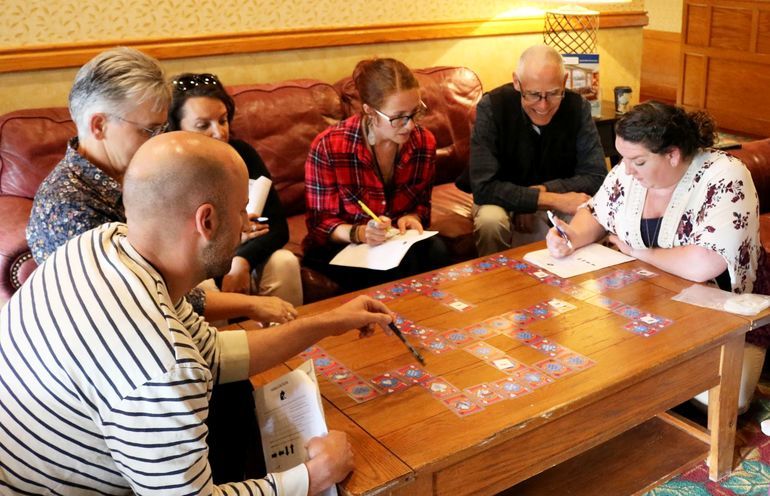New STEM recommendations promote education and workforce development
 COURTESY / Maine Mathematics & Science Alliance
A new set of recommendations aims to bolster Maine’s STEM education and workforce. Shown here is a Maine Mathematics and Science Alliance program to help educators integrate computer science and computational thinking into their classrooms.
COURTESY / Maine Mathematics & Science Alliance
A new set of recommendations aims to bolster Maine’s STEM education and workforce. Shown here is a Maine Mathematics and Science Alliance program to help educators integrate computer science and computational thinking into their classrooms.
A new set of recommendations aims to help bolster the state’s education system and workforce focused on STEM — science, technology, engineering and math.
The Maine State Chamber of Commerce, Maine Mathematics & Science Alliance and Science is US released the set of policy recommendations on Tuesday.
"The future of Maine's STEM workforce is rapidly evolving, as are the skills the youth of today will need to be successful in that workforce,” said Ruth Kermish-Allen, executive director of the Maine Mathematics & Science Alliance.
“Maine's education sector is working hard to integrate learning those transferable skills into classroom experiences today for youth. This is a new and challenging role for K-12 educators today and they need the supports, materials, training and connections to community STEM leaders to make STEM workforce readiness a reality.”
The policies are designed to complement and support the 10-year Economic Development Strategy unveiled by Gov. Janet Mills in 2019, and its focus on talent and innovation as a pathway to the state’s economic growth.
Recent data show that while STEM sector jobs are outpacing non-STEM fields nationally, Maine lags in developing a workforce for science and engineering jobs. Data also shows that Maine’s research and development investment is less than 1% of gross domestic product, compared to a regional average of about 4%.
To bridge the gaps, policies that invest in science and engineering from early education to workforce should be implemented.
“As state policymakers look to address multiple issues that are key to growing Maine’s economy and workforce, further investments in R&D and STEM education are important priority areas,” said Dana Connors, president and CEO of the Maine State Chamber of Commerce.
“The recommendations in this report provide helpful direction and guidance for Maine to advance STEM education and a stronger workforce to stay competitive regionally, nationally, and in the global economy.”
The report cited key policy recommendations for Maine that include the following:
Education
- Stronger investment in pre-K-12 mathematics and science education, including supporting educator professional development in the field of STEM K-12 education.
- Increased investment in afterschool STEM programs similar to those in Vermont and Pennsylvania.
- More interdisciplinary programs and applied research programs to broaden students’ skill sets at all education levels and integrate STEM into other subject areas to reflect the realities of how and where STEM is found in the real world.
- Greater access to broadband internet in the state for students and the workforce.
- Consideration of greater investments in STEM programs at schools throughout the state, such as STEM certificates, STEM-focused schools, maker spaces, and partnerships between local STEM businesses and schools.
- Expanded early college opportunities, especially in STEM fields, to diversify the curriculum options for high school students and put them on track to greater success in college and career.
Workforce
- More inclusive thinking for traditional industries as STEM jobs of the future and investment in the technology systems to advance the traditional agriculture, forestry, aquaculture and marine/shipbuilding/manufacturing economic sectors as well as future industries, such as offshore wind energy.
- Expanded investments in the Maine Economic Improvement Fund that support research and development within the University of Maine System.
- Leveraging and providing greater support for Finance Authority of Maine loans for specific workforce training programs.
- Industry-specific workforce development councils that focus on the future of specific industries and help foster resiliency and sustainable systems for industries into the future.
The recommendations were developed by the Maine State Chamber of Commerce, Science is US, and government, industry and academic leaders in the state as part of a science and engineering workforce roundtable series over the last year. The guidelines aim to inform key policy decisions in the state to strengthen Maine’s investment in science and engineering.
“STEM education and workforce preparation have never been more important to Maine’s future and the state has never been better positioned to engage students at all stages in high-impact, hands-on STEM learning and skill development that prepares them and our economy for success,” said Joan Ferrini-Mundy, president of the University of Maine and vice chancellor for research and innovation at the University of Maine System.
Click here to view the full report.
Mainebiz web partners
Two key elements missing from this plan is identifying who will be payed to teach these programs and what resources will be available at the schools. I volunteered to help part time with the STEM program at the Biddeford Elementary school. None of the teachers involved there had any educational or vocational experience in the STEM field except for math. What is worse is that most schools have eliminated the spaces they use to have for hands on vocational training. What I'm afraid is that most of the money allocated for this training will be spent on STEM related software and students will not get the hands on training they absolutely need to succeed in field.












1 Comments